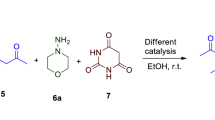Abstract
Acenaphthenequinone and its halogen derivatives readily undergo condensation with 2-thiohydantoin, thiazolidinedione-2, 4, and the N-phenyl and N-p-tolyl derivatives of the latter in acid medium, on boiling in the presence of anhydrous sodium acetate. Replacement of an oxygen atom in the thiazolodine ring by sulfur leads to bathochromic shift of UV absorption maxima both in solution in dioxane and in concentrated sulfuric acid. The large displacement of the spectral maxima in sulfuric acid as compared with dioxane is evidently due to salt formation.
Similar content being viewed by others
References
A. P. Karishin and Yu. V. Samusenko, ZhOrKh, 1, 1003, 1965.
A. P. Karishin and L. A. Solomakha, ZhOrKh, 1965 (in press).
Author information
Authors and Affiliations
Rights and permissions
About this article
Cite this article
Karishin, A.P., Timchenko, A.I., Dzhurka, G.F. et al. Condensation of acenaphthenequinone and its halogen derivatives with 2-thiohydantoin and thiazolidinedione-2, 4. Chem Heterocycl Compd 1, 473–480 (1965). https://doi.org/10.1007/BF00469922
Issue Date:
DOI: https://doi.org/10.1007/BF00469922




